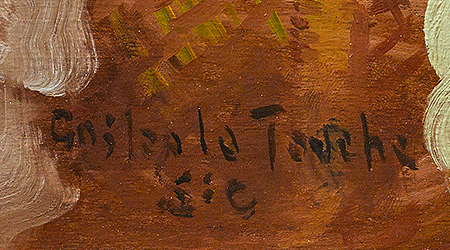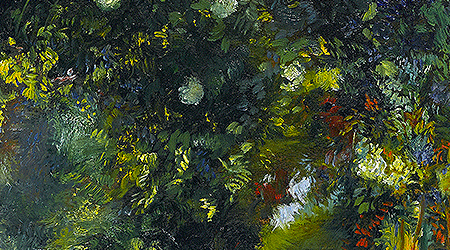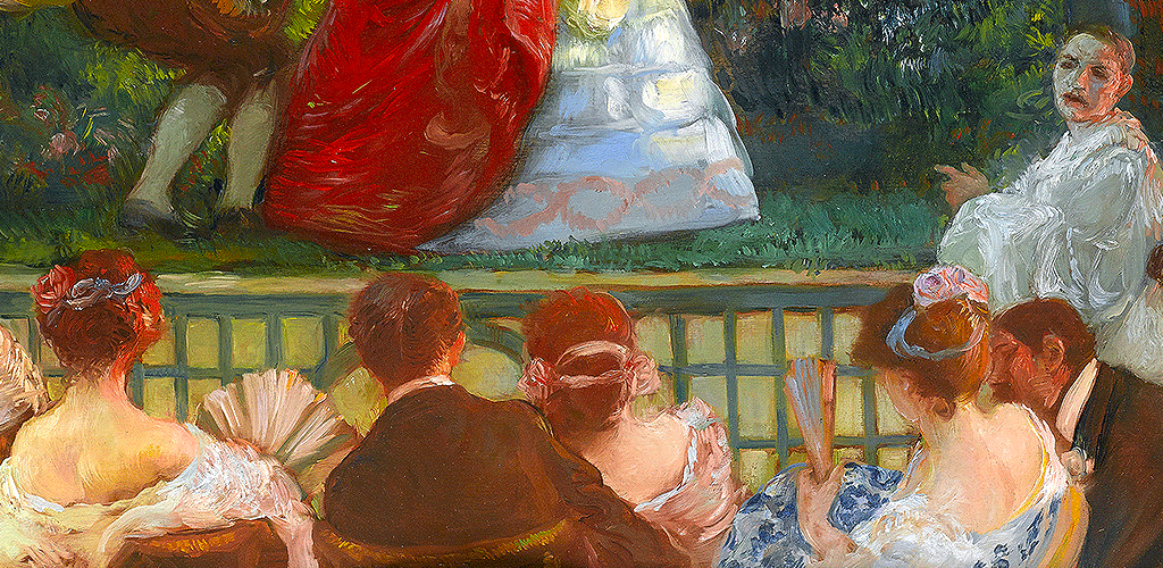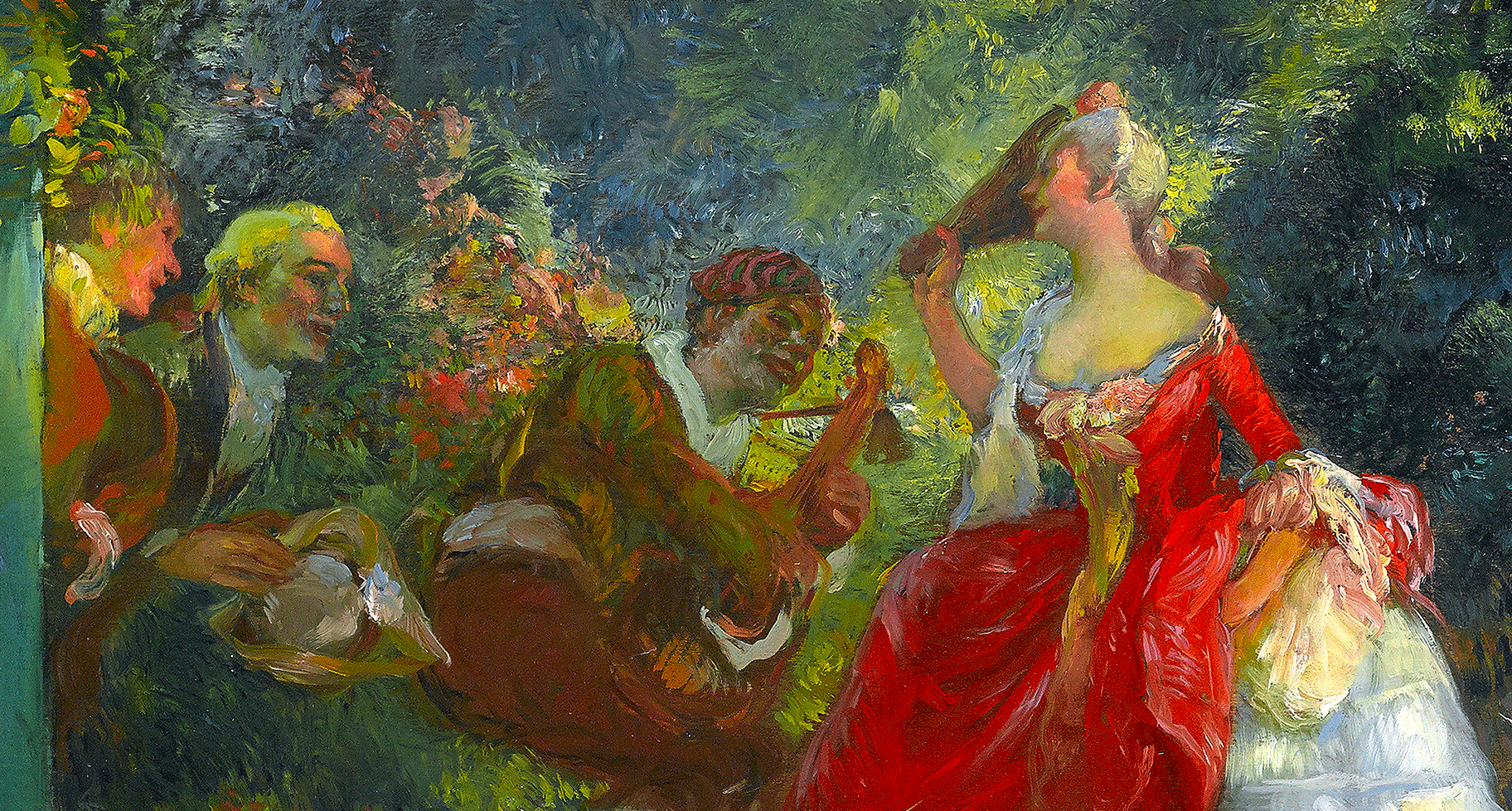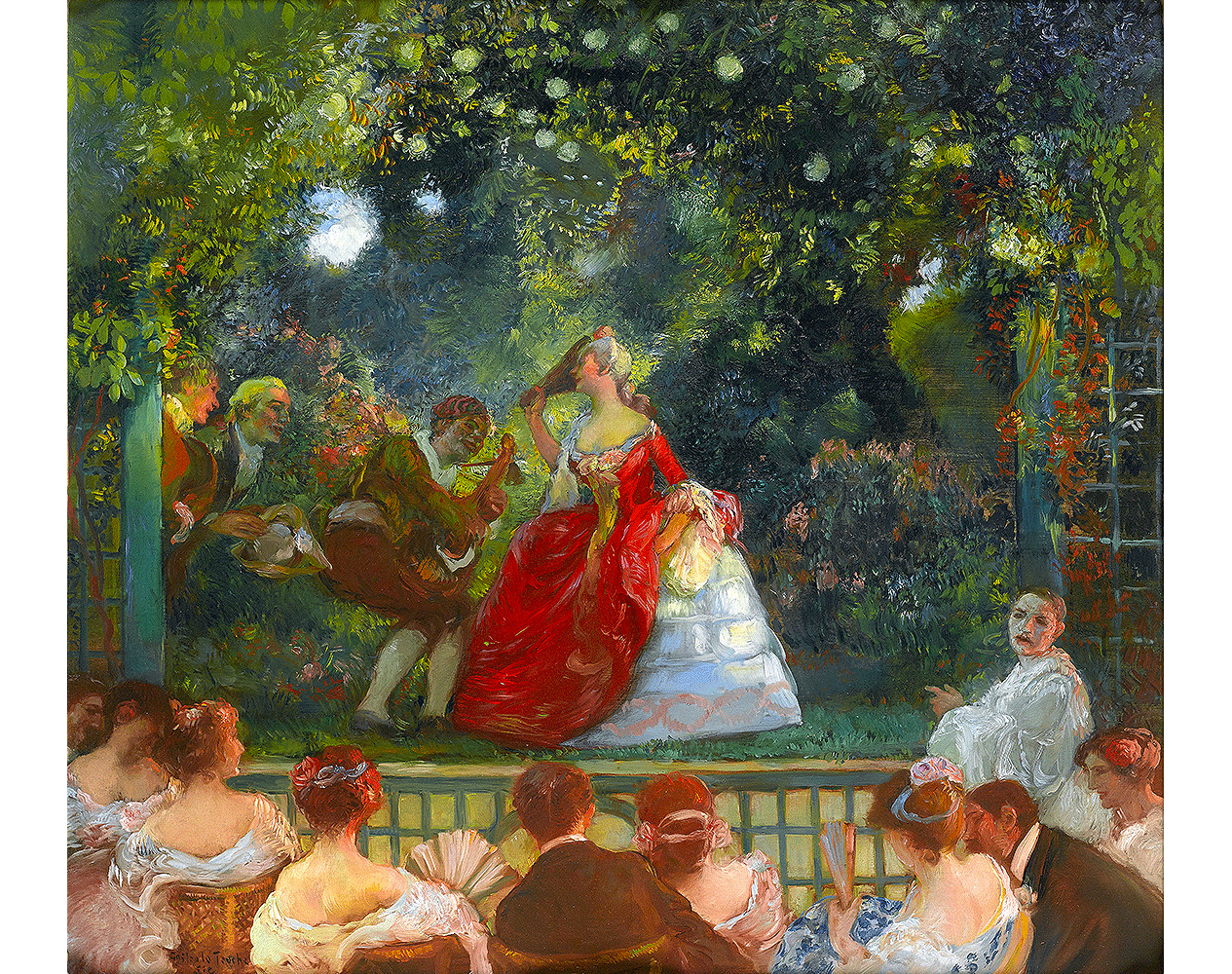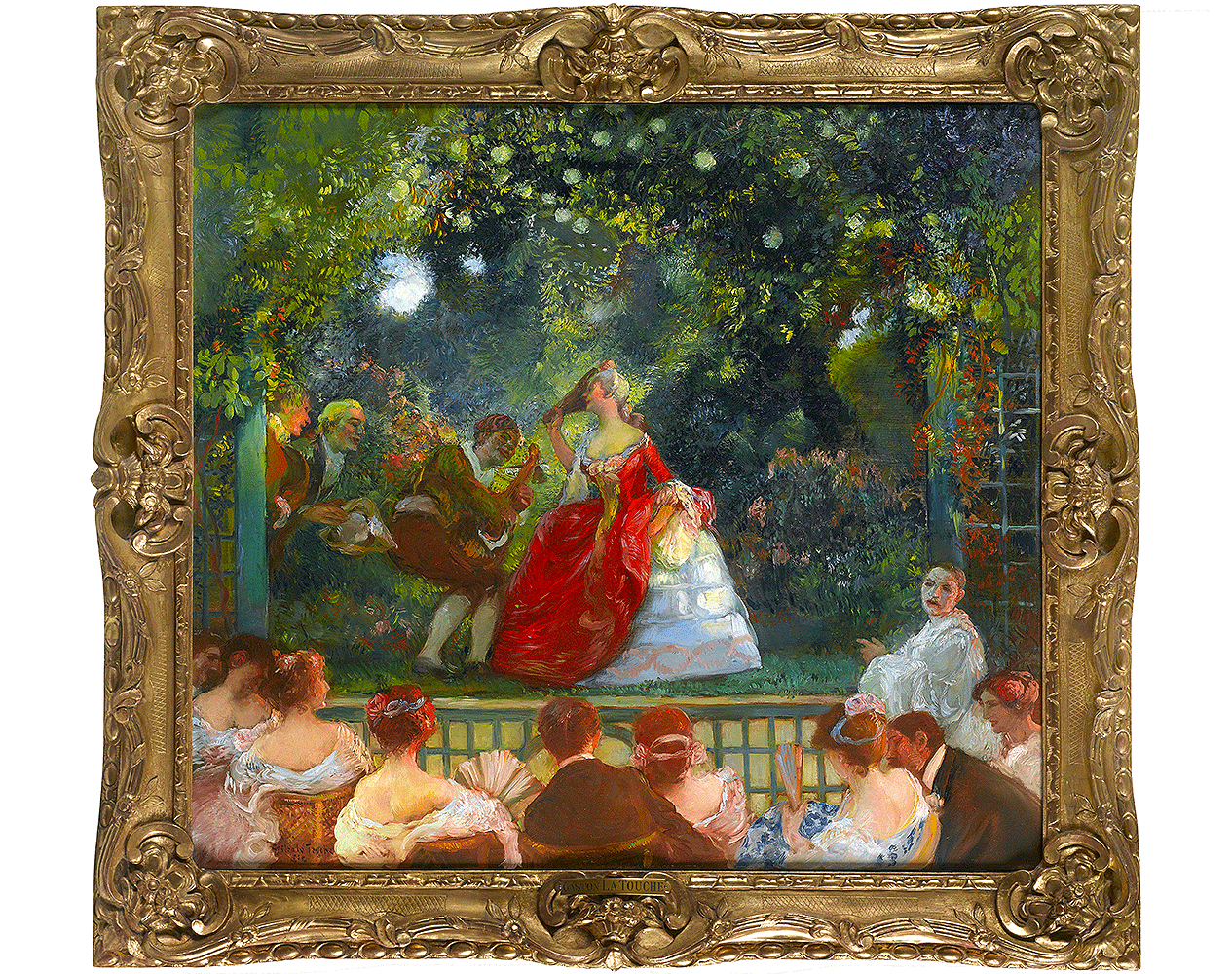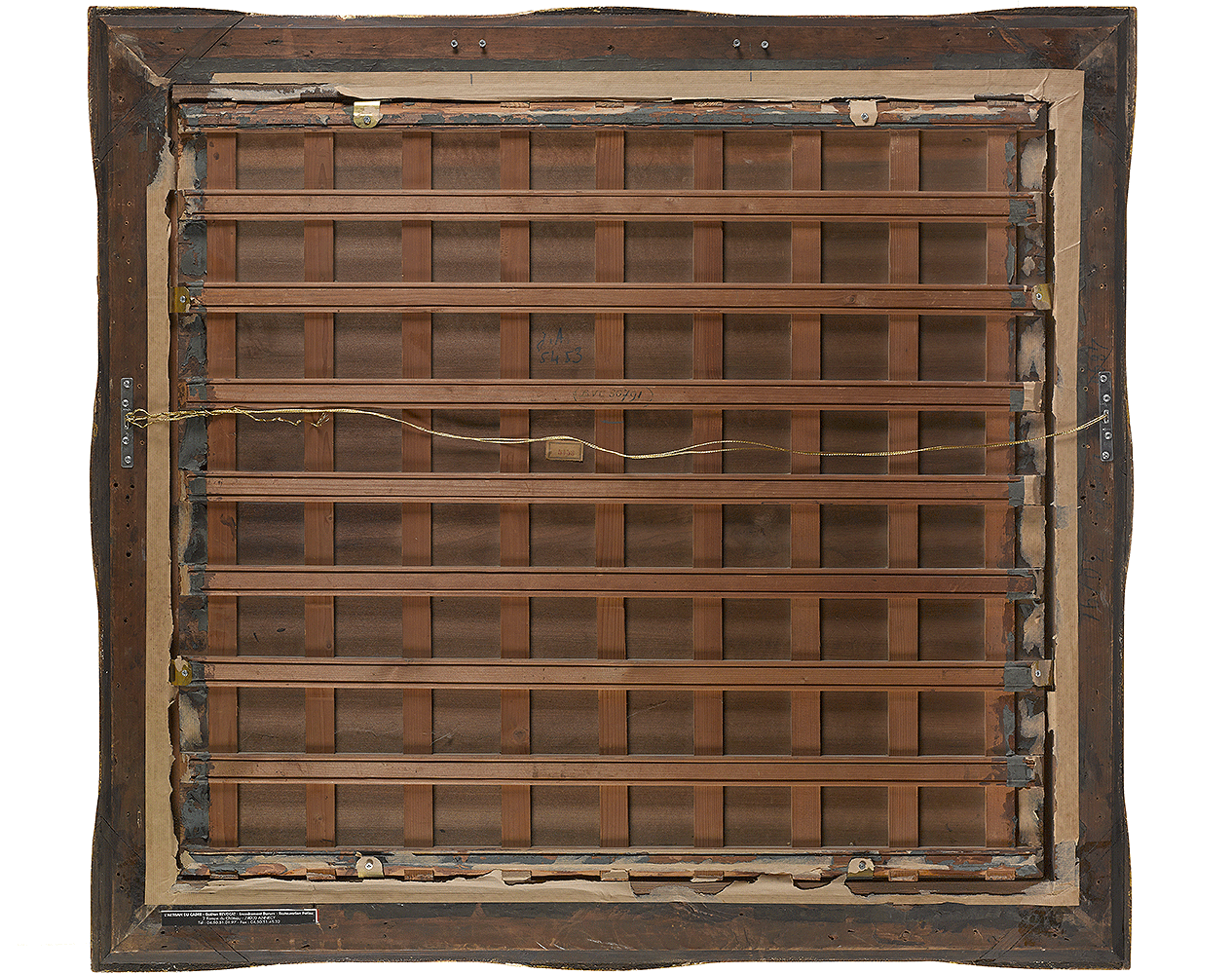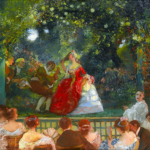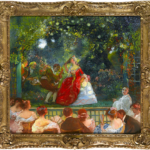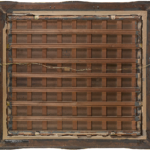The painting is a stunning example of the harmonious decorative style of the artist’s mature period. It shows his trademark delicate brushwork and beautifully vivid palette, and the subject matter reflects the influence of the Rococo painters, such as Watteau and Fragonard.
In this wonderful display of colour and technique, in La Touche’s characteristic style, he depicts a glorious scene set outside in an open-air theatre, popular in the late XIX – early XX century. The audience, comprising elegant men and women, grouped together in front of the stage, are enjoying a piece of theatre on a beautiful summer’s evening, the women gently fanning themselves in the warm dusk air. The figure to the right is perhaps taking part as narrator. The play appears to be set in the 18th century, according to the players’ costumes and the men with their tricorn hats.
The painting is signed and inscribed “StC” on the lower left to denote that it was painted at La Touche’s family home in St.Cloud, on the outskirts of Paris. St.Cloud was a wealthy town where many Parisians owned large villas. The town borders onto the Parc de St.Cloud where the Chateau de Saint-Cloud was located, which then leads onto Versailles.
Born in St.Cloud, near Paris on 29th October 1854, Gaston La Touche showed an early vocation for an artistic career. From the age of ten, he spent every available moment of recreation drawing, and eventually managed to obtain permission from his parents to take lessons from a Monsieur Paul. His teacher quickly discovered his natural aptitude and encouraged the young boy to persevere with his studies. Interrupted by the Franco-Prussian war of 1870, the lessons ceased when the family fled to Normandy. La Touche never received any further formal training, but he came under the influence of two older painters, one of whom in particular was to have a profound and far-reaching effect on the development of European painting. The two were Felix Bracquemond and Edouard Manet.
La Touche was born into one of the most exciting periods of Western Art – the Impressionist movement was gathering momentum and painting as we know it was to change forever. His early career was influenced by the Realist movement of which François Bonvin, Jean-François Millet, and Pascal Dagnan-Bouveret were the revered masters. Heeding Bracquemond’s advice, he showed two works, Les Phlox and Les Pivoines in his new style, the former being immediately purchased by the French State and is still hanging in the Musée de la Roche-sur-Yon today. La Touche was so overcome with this official recognition that he made a bonfire of some two hundred paintings in his early style that remained in his studio. He made another bonfire later in life, shortly before his untimely death in 1913.
In Europe, La Touche was represented by the most important dealers of his day: Georges Petit, Galerie Boussod & Valladon, Manzi Joyant and The Fine Art Society. Gaston La Touche had three main associations with America during his lifetime – the first was with the Carnegie Institute in Pittsburgh, where he exhibited nineteen paintings between the years 1897 and 1914. The other two associations were more personal. Through the close friendship between his wife and Madame Knoedler, La Touche exhibited regularly at M. Knoedler & Co in New York. This was the same dealer who assisted the titans of the period with the formation of their collections – men like Andrew Mellon, Samuel Kress and Henry Clay Frick to name but a few. The artist’s final American connection was with Cornelia B. Sage Quinton (1876-1936), the Director of the Albright Knox Gallery in Buffalo, New York. She was the first woman director of an American museum.
La Touche was extremely well-respected in his lifetime and was commissioned to paint numerous works for government and public buildings, including a suite of ‘Quatre Saisons’ for the Town Hall in Saint-Cloud, a decorative panel for the restaurant ‘Le Train bleu’ at the Gare de Lyon, The Senate and a large impressive work painted on a gold ground panel for the First Class Dining Room of the Liner SS France (1911). This ship was the rival to the Titanic and was known as the ‘Chateau of the Seas’.
One of his most important friendships was with the poet and playwright Edmond Rostand (1868-1918), famously known for his play “Cyrano de Bergerac”. La Touche painted a number of works for his home The Villa Arnaga in Cambo, which also housed a number of decorative panels by the Post-Impressionist artist Henri Martin (1860-1943). Upon the occasion of La Touche’s first solo exhibition in 1908 at the Galeries Georges Petit in Paris, Rostand wrote a wonderful poem for the catalogue. Other important clients included Raymond Poincaré, the French Prime Minister, Serge Shchoukine, Princess Tenicheff, M. Kousnitzoff (Odessa), Le Comte de Raczuskie, Mr.Calouste Gulbenkian and the King of Siam.
La Touche exhibited regularly at the Salon de la Société Nationale des Beaux-Arts and the Société des Peintres et Sculpteurs, as well as at the Société de la Peinture à l’Eau which he had founded in 1906 and of which he was president. A large exhibition at the Galeries Georges Petit was held in 1908 and another at Boussod and Valadon in The Hague, some two months before he died suddenly while working on a painting on 12th July 1913. La Touche’s paintings are held in major museum collections internationally, including the Hermitage Museum in St.Petersburg, Musée d’Orsay in Paris, the National Museum of Western Art in Tokyo, the Walters Art Museum in Baltimore, the Art Institute of Chicago, the Fine Arts Museums of San Francisco and others.
Selina Baring Maclennan and Roy Brindley
